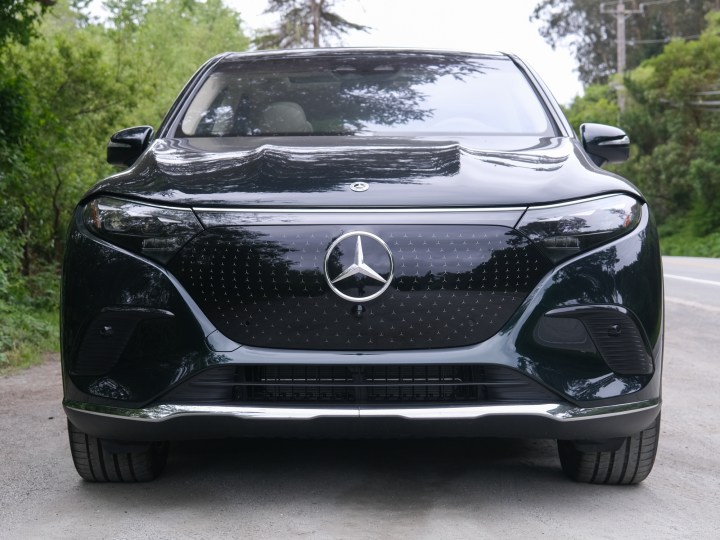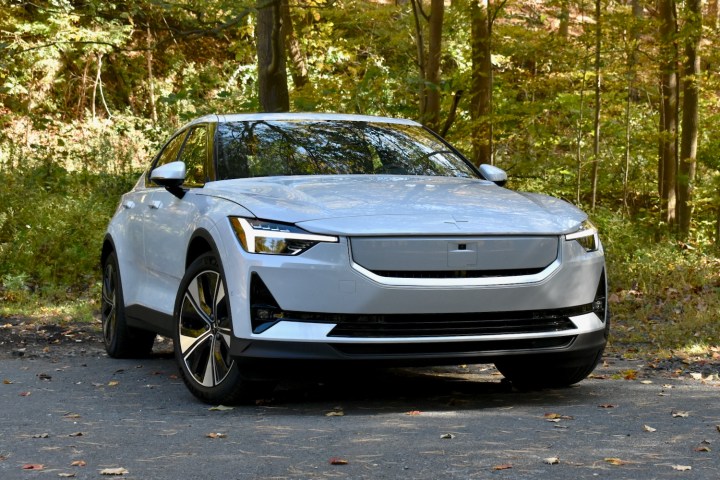Charging at home is a big part of owning an EV. DC fast charging is great, but it’s nowhere near as convenient as charging at home, more expensive, and not as good for your car’s battery. As such, most EV buyers will want to charge at home if possible. Thankfully, many EVs come with a home charger that you can use as soon as you get your shiny new car into your driveway.
But not all home chargers are created equal. Some are faster than others, and that can play a big role in how you charge your vehicle and when. Curious about who offers the best EV chargers for free with their cars? Here’s a look at all the major EV manufacturers and what you’ll get with their vehicles.
Audi
Included charger? Yes
Plug types: NEMA 5-15 (standard U.S. three-prong outlet), NEMA 14-50
Level 1 speed: 1.2kW
Level 2 speed: 11kW
All of Audi’s E-tron EVs come with the Audi Charging System Compact for free. The charger that comes with E-tron EVs supports charging at up to 11kW, but to hit those speeds, you’ll need to connect it to a more powerful NEMA 14-50 power outlet. The charger is compatible with both 120V and 240V outlets, but when connected to a traditional 120V plug, it can only deliver up to 1.2kW. It has a cord length of 4.5 meters, or around 14.8 feet, and a switch that allows you to select between 50% or 100% power, meaning that you can avoid overloading your home’s power capacity.
BMW

Included charger? Yes
Plug types: NEMA 5-15 (standard U.S. three-prong outlet), NEMA 14-50
Level 1 speed: 1.2kW
Level 2 speed: 9.6kW
All BMW EVs come with a BMW portable Flexible Fast Charger, which is compatible with both 120V and 240V outlets, allowing for both Level 1 and Level 2 charging. It supplies a charging speed of up to 9.6kW when connected to a 240V outlet, or up to 1.2kW when connected to a 120V plug. The charger has a cord length of 6 meters, or 20 feet.
Cadillac
Included charger? Yes
Plug types: NEMA 5-15 (standard U.S. three-prong outlet), NEMA 14-50
Level 1 speed: 7.7kW
Level 2 speed: 1.4kW
Cadillac EVs come with the Dual Level Charging Cord, which supports 120V and 240V power outlets for both Level 1 and Level 2 charging. When connected to a 240V outlet, this charger can deliver up to 7.7kW. However, when connected to a 120V plug, it only charges at 1.4kW. The cord length on the charger is an impressive 25 feet, and the charger is IP66 rated for both indoor and outdoor use.
Chevrolet

Included charger? Yes
Plug types: NEMA 5-15 (standard U.S. three-prong outlet), NEMA 14-50
Level 1 speed: 1.4kW
Level 2 speed: 7.7kW
Chevrolet EVs come with Chevrolet’s Dual Level Charge Cord, which supports both 120V and 240V power outlets for Level 1 and Level 2 charging. Its Level 2 speeds are up to 7.7kW, which are a little lower than some of the others on this list. Being the same as the Cadillac charger, this charger has a 25-foot cord and is IP66 rated, allowing you to charge outdoors.
Ford

Included charger? Yes
Plug types: NEMA 5-15 (standard U.S. three-prong outlet), NEMA 14-50
Level 1 speed: 1.4kW
Level 2 speed: 7.4kW
Ford EVs come with the Ford Mobile Power Cord or Mobile Power Charger, which supports both 120V and 240V charging, at up to 32 amps. It has a 20-foot cord and an IP66 rating for outdoor use. At Level 1 speeds, it can charge at up to 1.4kW, while at Level 2, it reaches 7.4kW.
At the time of this writing, Ford is going a step further. Between October 1, 2024, and January 2, 2025, Ford is giving new customers who buy or lease an F-150 Lightning, Mustang Mach-E, or E-Transit a Ford Charge Station Pro, which offers bi-directional power. This means your car can power your home in the event of a power outage. The Charge Station Pro is a Level 2 charger that’s built to be permanently installed in your home. It can deliver charging speeds of up to 19.2kW at 80 amps. Along with the charging station itself, Ford is also covering professional installation of the Charge Station Pro, which is pretty impressive.
GMC
Included charger? Yes
Plug types: NEMA 5-15 (standard U.S. three-prong outlet), NEMA 14-50
Level 1 speed: 1.4kW
Level 2 speed: 7.7kW
Like other GM brands, GMC EVs come with the Dual Level Charge Cord, which supports both 120V and 240V power outlets for level 1 and level 2 charging. The maximum charging speed you’ll get with this charger is 7.7kW. However, you’ll need to be connected to a 240V outlet to get those speeds. The charging cord is 25 feet, which makes it one of the longer charging cords that comes with an EV.
Hyundai

Included charger? Yes
Plug types: NEMA 5-15 (standard U.S. three-prong outlet)
Level 1 speed: 1.4kW
Level 2 speed: N/A
Hyundai electric vehicles come with a portable charger that only supports Level 1 charging speeds and plugs into a 120V traditional U.S. power outlet. With this charger, you’ll get speeds of up to 1.4kW. The charger supports between 6A and 12A, which you can select depending on your home’s electrical supply. Unfortunately, the charger does not support Level 2 charging of any kind, so for that, you’ll need to purchase a separate charger.
Kia
Included charger? Only with the EV9
Plug types: NEMA 5-15 (standard U.S. three-prong outlet), NEMA 14-50
Level 1 speed: 1.4kW
Level 2 speed: 7.7kW
Newly purchased Kia EV9s come with a third-party charger (the Webasto Go), which supports both level 1 and level 2 charging through 120V and 240V plugs, respectively. When charging at level 1 speeds, you’ll get 1.4kW, while level 2 charging will provide 7.7kW. The charger has an IP67 water resistance rating, so it can be used outdoors, and it has a cable length of 20 feet.
Shockingly (ha), other Kia electric vehicles, including the Kia EV6, don’t come with a charger of any kind. There’s no portable charging cable or home charger to be found when you purchase a Kia electric car. So if you want to charge at home, you’ll have to buy one separately. This is pretty disappointing to see from Kia, considering the fact that vehicles like the EV6 and EV9 are considered among the most desirable out there.
Lucid
Included charger? Yes
Plug types: NEMA 5-15 (standard U.S. three-prong outlet), NEMA 14-50
Level 1 speed: 1.3kW
Level 2 speed: 9.6kW
The Lucid Air comes with the Lucid Mobile Charging Cable, which supports charging through both 120V and 240V plugs. When plugged into a 120V power outlet, you’ll get Level 1 charging speeds of 1.3kW, while plugging into a 240V outlet will deliver Level 2 speeds of up to 9.6kW. The charger has a 20-foot cable, and can be used both indoors and outdoors.
Mercedes-Benz

Included charger? Yes
Plug types: NEMA 5-15 (standard U.S. three-prong outlet), NEMA 14-50
Level 1 speed: Unknown
Level 2 speed: Unknown
Mercedes-Benz includes a portable charging cable with new EVs, and we know that it comes with adapters for both 120V and 240V power outlets in the U.S. However, the company does not disclose the charging speeds that you’ll achieve with the charging cable.
Nissan
Included charger? Yes
Plug types: NEMA 5-15 (standard U.S. three-prong outlet)
Level 1 speed: 1.4kW
Level 2 speed: N/A
Nissan offers a mobile charger with its EVs. However, the charger only works with a traditional 120V power outlet and supports Level 1 charging speeds of 1.4kW. It does not support Level 2 charging. For those who want to charge at faster speeds, it’s worth considering buying a separate home charger.
Polestar

Included charger? Yes
Plug types: NEMA 5-15 (standard U.S. three-prong outlet), NEMA 14-50
Level 1 speed: 1.4kW
Level 2 speed: 11kW
Polestar electric vehicles come with a mobile charger that supports both Level 1 and Level 2 charging speeds. Like many of the others, the Level 1 charging speeds hit 1.4kW, while the Level 2 speeds reach a decently high 11kW. It has a cord length of 14 feet, which is relatively short, so you’ll likely want to ensure it’s installed relatively close to where the charging port of the vehicle will be in your garage.
Porsche
Included charger? Yes
Plug types: NEMA 5-15 (standard U.S. three-prong outlet), NEMA 14-50
Level 1 speed: 1kW
Level 2 speed: 9.6kW
Porsche electric vehicles come with the Porsche Mobile Charger Plus, which offers Level 1 charging speeds of 1kW and Level 2 charging speeds of 9.6kW when connected to a 240-volt U.S. power outlet. The Mobile Charger Plus has a cable length of 15 feet, which is relatively short. It also has an IP55 water resistance rating for outdoor use.
Rivian

Included charger? Yes
Plug types: NEMA 5-15 (standard U.S. three-prong outlet), NEMA 14-50
Level 1 speed: 1.2kW
Level 2 speed: 7.6kW
Rivian vehicles come with the Rivian Portable Charger, which supports Level 1 and Level 2 charging. Through a 120V power outlet, you’ll get Level 1 charging speeds of 1.2kW, while a 240V power outlet will deliver Level 2 speeds of 7.6kW. The portable charger is weatherproof, so it can be used outdoors, and it has an 18-foot cord.
Subaru
Included charger? Yes
Plug types: NEMA 5-15 (standard U.S. three-prong outlet)
Level 1 speed: 1.4kW
Level 2 speed: N/A
Subaru EVs come with a portable charging cable; however, it only supports Level 1 charging speeds through a typical 120V U.S. power outlet.
Tesla

Included charger? No
Tesla stopped including chargers with its vehicles a few years ago. This is hugely disappointing and means that customers who want a basic home or portable charger will have to spend extra cash to get one.
Toyota
Included charger? Yes
Plug types: NEMA 5-15 (standard U.S. three-prong outlet), NEMA 14-50
Level 1 speed: 1.4kW
Level 2 speed: 7.6kW
Toyota EVs like the BZ4X come with a charger that supports both Level 1 and Level 2 charging speeds. Level 1 speeds sit at 1.4kW, while Level 2 speeds hit 7.6kW when connected to a 240V power outlet.
Volkswagen
Included charger? Yes
Plug types: NEMA 5-15 (standard U.S. three-prong outlet), NEMA 14-50
Level 1 speed: 1.4kW
Level 2 speed: 7.7kW
Volkswagen EVs come with the Volkswagen 2-in-1 Mobile EV Charge Cable, which supports both Level 1 and Level 2 charging. When connected to a 120V power outlet, you’ll get Level 1 charging speeds of 1.4kW, while a 240V outlet will deliver Level 2 speeds of 7.7kW. The charger has a 20-foot cord.
Volvo

Included charger? Yes
Plug types: NEMA 5-15 (standard U.S. three-prong outlet), NEMA 14-50
Level 1 speed: 1.3kW
Level 2 speed: 11kW
Volvo EVs come with a mobile charger that supports both Level 1 and Level 2 charging speeds. Level 1 speeds reach 1.3kW, while Level 2 speeds through a 240V power outlet can reach 11kW. The charger has a 14-foot cord.
Who has the best EV charger?
It’s probably easier to say who has the worst charger than who has the best. The worst on this list include Tesla, which doesn’t offer a charger at all, and Kia, which only includes a charger with the EV9. All the others are pretty similar, offering a dual charger that can plug into a 120V or 240V power outlet and deliver charging speeds of up to around 11kW. The takeaway? No matter what EV you get, it’s probably worth looking into a decent, professionally installed charger for your home.




